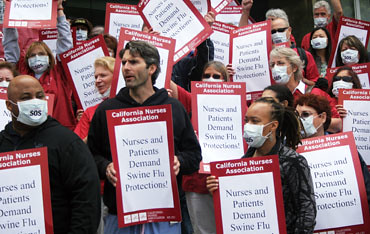16,000 Registered Nurses at 39 Catholic Health systems hospitals across California will strike this October 30th in an urgent bid to improve patient safety standards at their facilities, especially as the swine flu comes barreling down upon us.
This strike marks a continuation of a months-long effort by the California Nurses Association/National Nurses Organizing Committee (CNA/NNOC) to raise alarms about inadequate H1N1 hospital safeguards, and patient sfety in general.
In August, CNA/NNOC releaseda major report of a survey of 190 U.S. hospitals where RNs cited widespread problems with poor segregation of patients, lack of sufficient N95 masks, numerous hospitals where nurses have been infected, inadequate training for hospital staff, and punitive sick leave policies.
In particular, the RNs say, many hospitals continue to do a poor job at isolating patients with H1N1 symptoms and other steps to limit contagion, or provide sufficient fit-tested N95 respirators and other protective gear for healthcare workers and patients.
“Our hospital isn’t being proactive in preparing for the expected onslaught of H1N1 infected patients,” said Kathy Dennis, RN at Mercy General Hospital in Sacramento. “We can’t get enough N95 masks, patients are not being properly isolated, and RNs are not being kept informed of the latest guidelines. Last time I worked, It took me more than four hours to get masks when we ran out we ran out. We must put the proper precautions in place now before flu seasons peaks or we will all be in serious trouble.”
CNA/NNOC wants hospitals to formally adopt all CDC and Cal-OSHA guidelines to make them enforceable by CNA/NNOC contract provisions assuring the highest safety measures are met, are uniform, and consistently applied throughout the systems.
Another nurse put the problems this way: “When nurses are exposed to tuberculosis, the hospital notifies us. When nurses are exposed to head lice the hospital notifies us. Why then are we not told when we are exposed to H1N1? All staff have the right to know if they have been exposed in order to keep our patients from further unnecessary exposure,” said Carol Koelle, RN at St. Bernardine Medical Center in San Bernardino.
The union decided to strike after “an onslaught” of patients admitted to hospitals made negotiations more urgent, said Jill Furillo, who heads union bargaining with Catholic medical facilities. She said the union was mainly striking over safety issues: “This is not really about money.”
The union is asking the health-care systems to create a monitor position to ensure that staffing ratios comply with California state mandates. The union also said it wants hospitals to stop a practice called “floating,” in which nurses are assigned to areas outside of their expertise, such as an emergency-room nurse being assigned to labor and delivery.
A union official also said a few hospitals are seeking salary freezes, which the union is fighting, and some hospitals have proposed increasing employee payments for health insurance.
Nurses have been demanding more protection from the H1N1 flu all summer, an association spokesman said, but became increasingly concerned after a nurse died in July. Karen Ann Hays, 51, a cancer nurse at Mercy San Juan Medical Center in Sacramento, died July 17 of a severe respiratory infection, pneumonia and H1N1. Hospital officials could not confirm whether Hays, a triathlete and marathon runner, became ill at work.
While nurses have made a major focus on passing the Employee Free Choice Act, and removing the barriers that most RNs face in joining a union, this effort shows the power that a revitalized labor movement can have even before labor laws are-finally-reformed.
The responses by the hospitals to this strike should serve to make very clear why nurses had to take this difficult and brave step. Their responses are: 1. Blame the messenger, 2. Deny patients need RN care, and 3. Cry poor. All of which should serve to put both patients and nurses on notice that these facilities are in full denial mode. More specifically:
Jan Emerson, a spokeswoman for the California Hospital Association, said the union was “grandstanding” by raising the respirator issue.
Tobey Robertson, spokeswoman for Community Hospital of San Bernardino, said the hospital will take into account skill levels needed on the day of strike. “You don’t always need RNs to replace RNs. It depends on the level of care,” she said.
3. Finally, patients were told by another local hospital spokesperson that they can’t afford safe care:
“Given the current economic environment and the challenges CHW faces, the CNA’s demands, if agreed to, would add to the ballooning cost of providing care and threaten our ability to meet our community’s needs,” the statement said.


